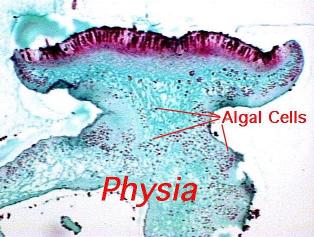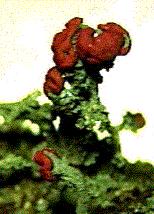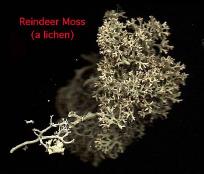







Lichens are formed from a combination of a fungal partner (mycobiont) and an algal partner (phycobiont). The fungal filaments surround and grow into the algal cells, and provide the majority of the lichen's physical bulk and shape. In the picture below at left of the lichen Physia, the fungal filaments have been stained blue, and the scattered algal cells red.
Also in the Physia section, you may notice a dark red layer along the top. This is an apothecium, much like the ones atop the British soldier lichen, below at right. An apothecium is a fungal reproductive structure, in which the fungus reproduces itself through the production of spores. These spores will disperse and germinate into new fungi, but they will not produce new lichens. For a lichen to reproduce, but the fungus and the alga must disperse together.
Lichens reproduce in two basic ways. Firstly, a lichen may produce soredia, or a cluster of algal cells wrapped in fungal filaments. These may disperse and form new lichens. A second way for the lichen to reproduce itself is through isidia, which are much like soredia except that isidia are enclosed within a layer of protective cortex tissue. An isidium is much more like a miniature lichen.
 |
 |
Lichens will grow almost anywhere that a stable and reasonbly well-lit surface occurs. This may include soil, rock, or even the sides of trees. A lichen may absorb certain mineral nutrients from any of these substrates on which it grows, but is generally self-reliant in feeding itself through photosynthesis in the algal cells. Thus, lichens growing on trees are not parasites on the trees and do not feed on them, any more than you feed on the chair you sit in. Lichens growing in trees are simply using the tree as a home. Lichens growing on rocks, though, may release chemicals which speed the degradation of the rock into soil, and thus promote production of new soils.
Most lichens are temperate or arctic, though there are many tropical and desert species. Lichens seem to do better in drier environments, where they are not often left in standing water. What the lichen considers dry, however, may not be what we would consider to be dry. In bayous and in cool rainforests, large lichens known as "old man's beard" may often be seen hanging from the branches of trees. Though there is considerable water in these habitats, the air is not saturated, and drying breezes may serve to dessicate arboreal organisms.
 Lichens are most noticeable on the tundra, where lichens, mosses, and
liverworts constitute the majority of ground cover. This cover helps to
insulate the ground, and may provide forage for grazing animals. The
so-called Reindeer "moss" is one such lichen.
Lichens are most noticeable on the tundra, where lichens, mosses, and
liverworts constitute the majority of ground cover. This cover helps to
insulate the ground, and may provide forage for grazing animals. The
so-called Reindeer "moss" is one such lichen.
Thus, lichens are hardy creatures able to survive in scorching deserts and frosty tundra. Their secrets of success are not well understood however. Two key features suggested as having important roles are (1) their ability to survive drying and (2) their complex chemistry.
Lichens may dry completely when moisture is unavailable. This is not simply dehydration as it occurs in plants and animals we are familiar with, but a complete loss of body water such that the lichen becomes quite brittle. When moisture is again available, they quickly absorb water, becoming soft and fleshy again. Not only can lichens undergo this drying, but while they are dry and brittle, pieces may flake off and later grow into new lichens.
The chemistry of lichens is rather complex but well-studied. Lichens manufacture a host of chemicals which presumably serve to reduce attacks by predators. Only a few insects feed on lichens -- some moths and beetles among them.
The most serious threat to the continued health of lichens is not predation, but the increased pollution of this century. Several studies have shown serious impacts on the growth and health of lichens resulting from factory and urban air pollution. Because some lichens are so sensitive, they are now being used to quickly and cheaply assess levels of air toxins in Europe and North America.


